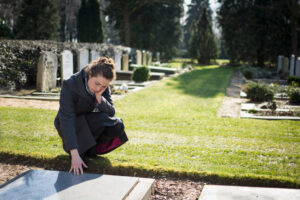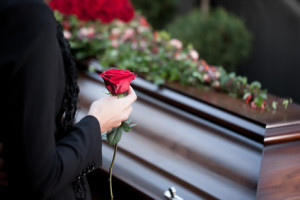Medicalizing Normal, Human Grief
Well, it’s official. If your bereavement over the death of someone close to you “lasts longer than social norms and causes distress or problems,” it could be a psychiatric disorder. The symptoms of what is called Prolonged Grief Disorder (PGD) include: avoiding reminders that the person is dead; emotional numbness; feeling life is meaningless; feeling intense loneliness, being detached from others; intense emotional pain related to the death. PGD can be diagnosed if someone is experiencing these symptoms within 12 months of the death of a loved one for adults or within 6 months for children or adolescents.
Prolonged Grief Disorder is the newest disorder added to the DSM. After studies suggested that many people were experiencing persistent difficulties with bereavement, PGD was approved by the APA’s Board of Trustees and Assembly in the fall of 2020 and included in the text revision of the DSM-5 (DSM-5-TR) published in March of 2022. The APA CEO and Medical Director said including prolonged grief disorder in the DSM-5-TR will mean that mental health clinicians and family members will “share an understanding of what normal grief looks like and what might indicate a long-term problem.” The President of the APA was quoted as saying:
The circumstances in which we are living, with more than 675,000 deaths due to COVID, may make prolonged grief disorder more prevalent. . . . Grief in these circumstances is normal, but not at certain levels and not most of the day, nearly every day for months. Help is available.
The reaction by mental health professionals has not been all supportive of the APA adding grief to the DSM listing of psychiatric disorders. Debate over this action has been going on for over a decade and it seems the APA has been incrementally moving in this direction. In 2013 when the bereavement exclusion was removed from the DSM-5 diagnosis of major depression, Allen Frances, who was the chair for the DSM-IV, thought it was a dreadful mistake that flew in the face of clinical common sense. He ranked it as the second worst mistake within the DSM-5. In a 2012 NYT article, “Grief Could Join List of Disorders,” he said: “What I worry about most is that the revisions will medicalize normality and that millions of people will get psychiatric labels unnecessarily.”
A recent NYT article about the addition of PGD to the DSM, “How Long Should It Take to Grieve? Psychiatry Has Come Up With an Answer,” said the new diagnosis was meant to apply to a narrow section of the population whose struggles with bereavement and grief kept them from resuming their previous activities. Joanne Cacciatore, who runs a retreat for bereaved people and has written extensively on grief, said she utterly disagreed that grief could be a mental illness. “To me, that is an incredibly dangerous move, and short sighted.”
Ellen Barry, the author of “How Long Should It Take to Grieve?”, predicted the new diagnosis will most likely open a stream of funding for treatments, “and set off a competition for approval of medicines by the Food and Drug Administration.” She noted how Holly Prigerson other researchers are investigating naltrexone in clinical trials as a form of grief therapy. Donna Schuurman, an internationally recognized authority on grief, predicted in “The Grief Pill is Coming!” that it will become “another massive disappointment in a long line of pharmaceutical marketing deceptions.” Their hypothesis is that PGD is a disorder of addiction; and that patients with PGD continue to “crave” their loved ones after they have died, as a result of the positive reinforcement of their memories of loved ones.
The Origins of Prolonged Grief Disorder
The origins of PGD date back to the 1990s and the work of a psychiatric epidemiologist named Holly Prigerson. She was part of a research team examining the effectiveness of depression treatment in older adults. She noticed many individuals responded well to antidepressant medications, but seemed to be unaffected when she looked at the grief measures used in the study. Her observations were dismissed by psychiatrists on the research team. She was told grief was normal, but she didn’t ignore her observations; she did more research.
Her further research showed that for most people, symptoms of grief peaked at six months postloss, six months after the death. In “An Empirical Examination of the Stage Theory of Grief,” she said a depressive mood in normally bereaved individuals tended to peak around six months postloss. Yearning, not depressed mood was the significant psychological response to natural death. She suggested her findings should lead to a revision of the DSM.
The results also offer a point of reference for distinguishing between normal and abnormal reactions to loss. Given that the negative grief indicators all peak within 6 months, those individuals who experience any of the indicators beyond 6 months postloss would appear to deviate from the normal response to loss. These findings also support the duration criterion of 6 months postloss for diagnosing complicated grief disorder, or what is now referred to as prolonged grief disorder. Unlike the term complicated, which is defined as “difficult to analyze, understand, explain,” prolonged grief disorder accurately describes a bereavement-specific mental disorder based on symptoms of grief that persist longer than is normally the case (ie, >6 months postloss based on the results of the present study). Furthermore, prolonged grief disorder permits the recognition of other psychiatric complications of bereavement, such as major depressive disorder and posttraumatic stress disorder. Additional analyses are needed to examine grief trajectories among those meeting criteria for prolonged grief disorder.
So it seems that Prigerson’s work and that of others who built upon it, led ultimately to the recent action by the American Psychiatric Association making PGD a formal diagnosis. Around 5% of the population experience grief feelings which are profoundly different, longer-lasting and more harmful than the typical bereavement after the death of a loved one. And according to some mental health professionals, this grief can be reliably distinguished from other MH conditions such as depression or post-traumatic stress disorder. Maarten Eisma told Gizmodo, “It diverges from normal grief in its duration and intensity as well as in its impact on everyday life.”
Prigerson said the American Psychiatric Association “begged and pleaded” to define the syndrome conservatively as a year after death to avoid a public backlash. The concern was that everyone feels they still feel some grief at six months. “It just seems like you’re pathologizing love.” She estimated the criteria for PGD should apply to around 4% of bereaved people.
Those who oppose the new diagnosis seem to voice concerns similar to that of Allen Frances, that it gives individuals a diagnostic label unnecessarily; it medicalizes normal human grief experience. Joanne Cacciatore told Gizmodo that the diagnostic criteria for PGD unfairly targeted a subset of grieving people to be diagnosed with a mental illness. Her own research with bereaved parents suggested a majority could experience symptoms that could lead to a diagnosis of PGD or other psychiatric diagnoses up to four years after their child’s death. If this many parents can feel this amount of grief, “perhaps it is the measures that are flawed, not the grievers.”
For example, the criteria states that at one year, you can be diagnosed with PGD if you are intensely yearning for the person who died. What parent would not yearn for a child who died? Intense emotional pain? After such traumatic losses, what person would not feel intense emotional pain one year later?
Cacciatore thinks the diagnostic system is “absolutely broken, and we need an ethical change.” Psychological care should not depend soley on a diagnosis. She thinks we need better grief support education. We need more facilitators and facilities to care for people who are grieving.
Sheila Vakharia noted that in a world where thousands of Americans per week are dying in an ongoing pandemic, how can anyone’s grief over the losses they’ve experienced be considered abnormal? “For a diagnosis such as this to be released at this moment, it just feels tone deaf, and it feels decontextualized, both within the broader policy environment and with the fact that we are in a mass disabling and a mass death event—we’re in a global pandemic.”
For more information on diagnosing grief, see “The Death of Grief” and “Pathologizing Grief.”


